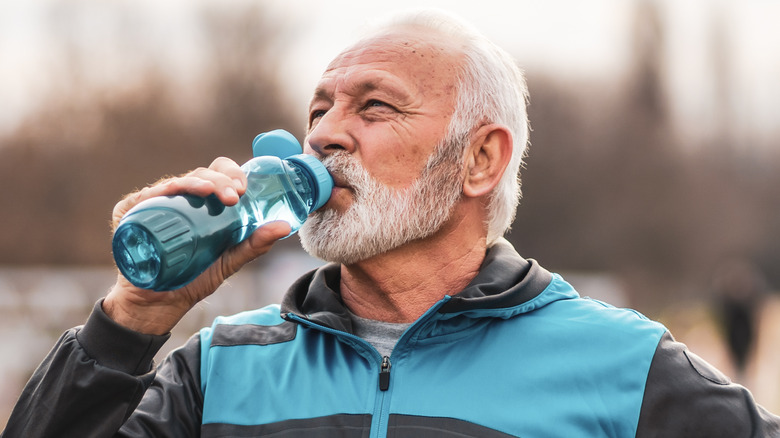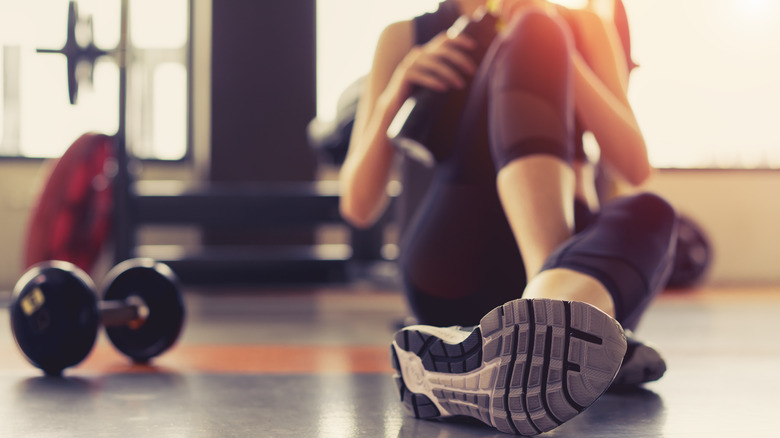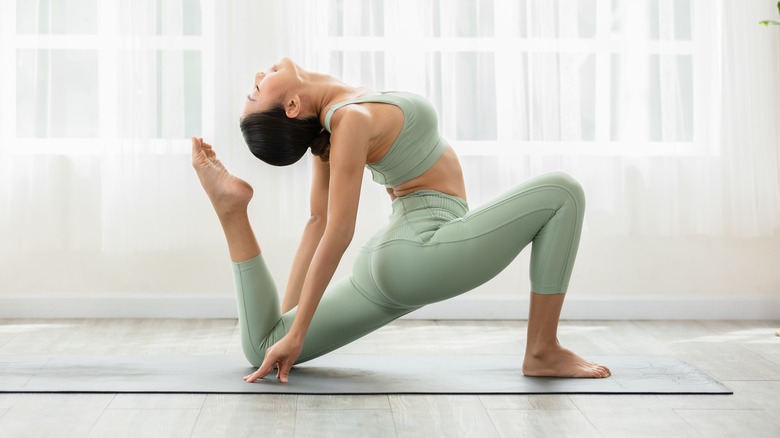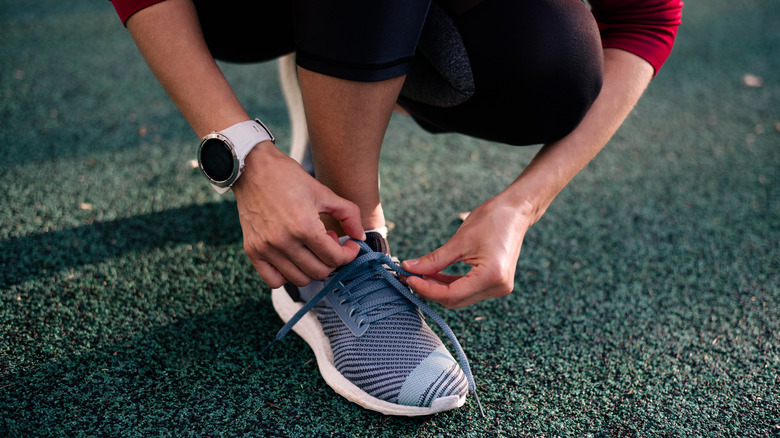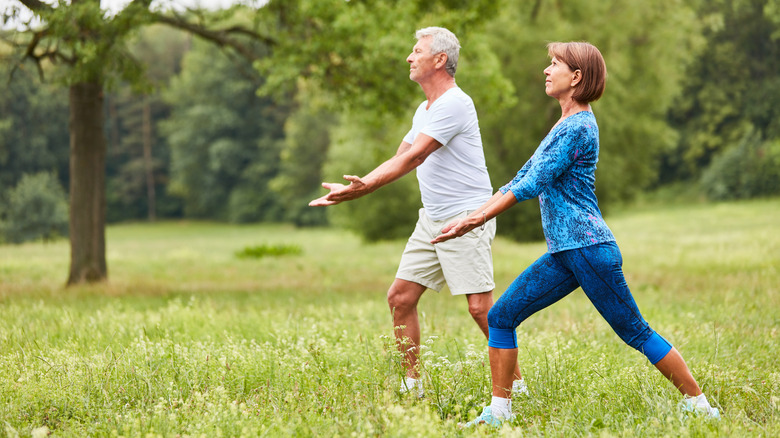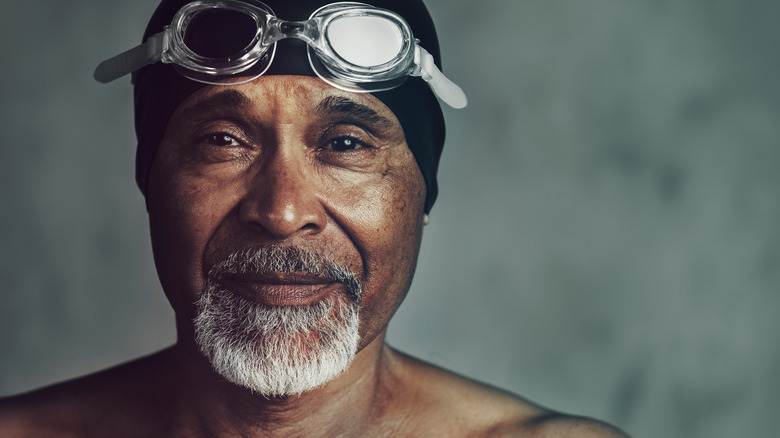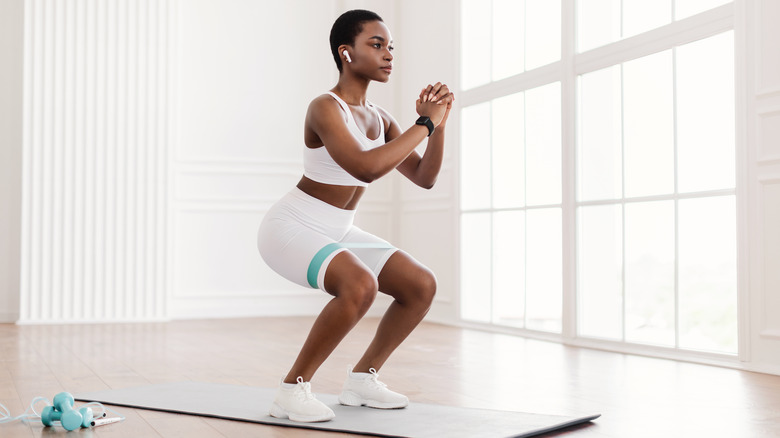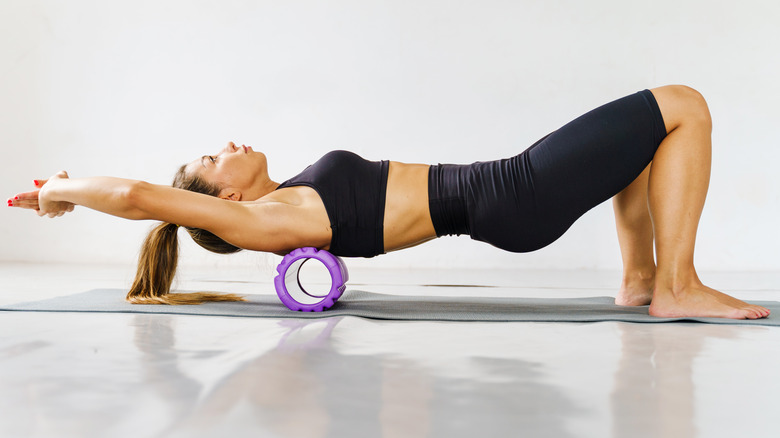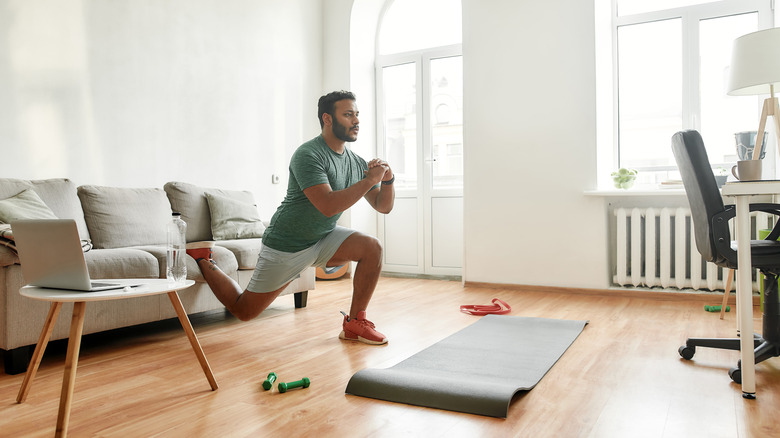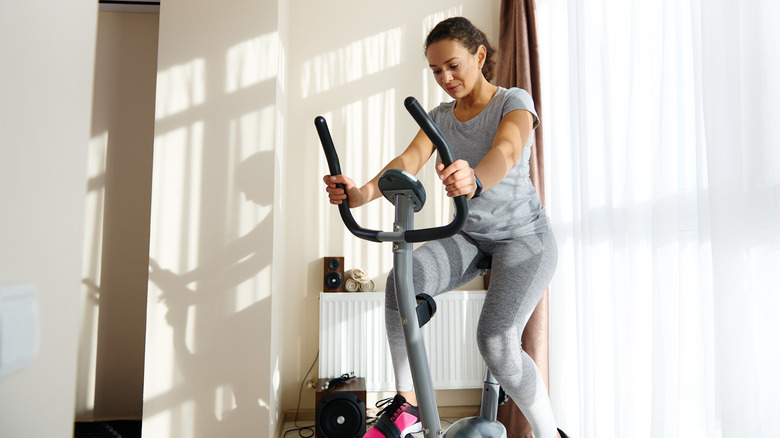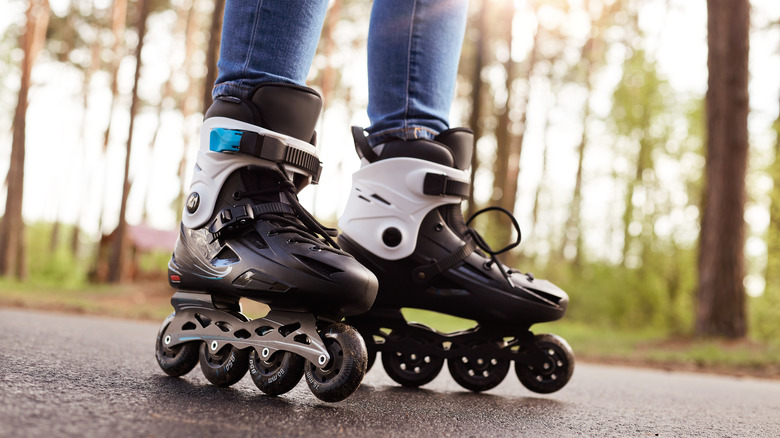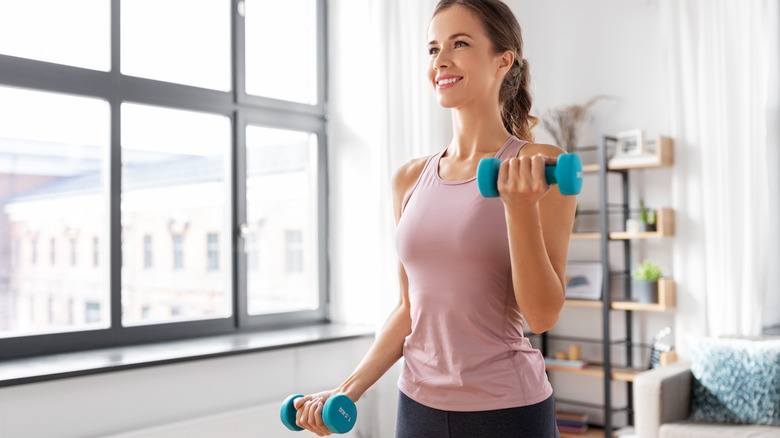14 Things You Can Do During Active Recovery
When it comes to exercise, the emphasis is often well and truly on how hard you're crushing it at the gym. But your moments away from exercise are as important as the work you put in, and when those treasured rest days roll around, what do you do with them? Sit on the couch with your feet up?
While we would say a resounding yes to that suggestion, there are ways to maximize your recovery that will have you bouncing back stronger. Practicing active recovery is one such way. Active recovery — low-intensity exercise activities performed on rest days or after workouts — helps maintain blood flow around your body following high-intensity exercise (via International Sports Sciences Association). It aids in recovery, reestablishes much-needed flexibility, and reduces muscle soreness. But finding the right balance of active versus too active can take a little practice — and much depends on finding the right recovery exercise for you.
Why is active recovery so important?
With anything related to fitness, we're often told that something is good or bad for us — but sometimes, it's hard to know exactly why that's the case. Active recovery is one such example of this, and so we wanted to break it down. When you exercise, your muscles become fatigued, and the length of recovery it takes for them to get back to full health varies, sometimes extending into multiple days, states Medical News Today. By performing active recovery exercises, you help to bring down the length of time your muscles take to recover, by increasing blood flow to the affected muscles.
By activating your muscles less intensely on recovery days, you can also help to decrease the buildup of lactic acid in your muscles (per research published in Frontiers in Physiology). It can also help to stop you from feeling so achy after exercise, and help to sift out metabolic waste from your muscles (via Medical News Today). All of these factors, ultimately, help your body become more ready to exercise again faster, something we can definitely get on board with.
Yoga
As one of the most gentle yet effective forms of exercise out there, it's little wonder that some forms of yoga are a top choice for active recovery days. Less intense forms of yoga, which encourage blood flow throughout the body without too much effort exerted, can help your body regain equilibrium. "Sequences with longer holds, slower movements, and props for support and alignment can be great opportunities to deepen your breath, drop your shoulders, and reset the mind-body conversation," advises yoga instructor and NASM-certified personal trainer Denis Morton to PopSugar. Leaning toward floor-based poses that can be held for several minutes at a time, like the Pigeon stretch, can help keep your yoga practice passive yet restorative, adds yoga instructor Kylan Fischer.
However, not all yoga is created equal. More intense yoga styles, like Vinyasa or hot yoga, are more focused on delivering a power-based and intense workout, and so are best left for actual workout days. And if your exercise has left you aching to the point that you think you might be injured, it's highly advisable to skip the yoga altogether and focus on recovery. "In the end, simply listen to your body," says Fischer.
Walking
We're just going to say it: We think walking gets a bad rap as exercise. Largely ignored in favor of more hardcore forms of movement, walking is a low-intensity exercise that is not only highly modifiable to make it more strenuous (should you wish), but in its basic form has a wealth of health benefits. "It stimulates blood flow to the brain and the rest of the body, boosting our metabolism, reducing feelings of anxiety and stress, and improving our overall mood. It also lowers blood pressure," says Ireland-based certified personal trainer Ben Walker to Eating Well. It's this stimulation of blood flow that allows it to be particularly restorative as an active recovery exercise, helping to reduce symptoms of soreness and stiffness, says Healthline.
Even a brisk walk can aid with recovery following a hard workout, but amping up your walking time to around 30 minutes daily can offer benefits beyond just being able to exercise again faster. Half an hour of walking in one go, or three 10-minute walks throughout a day, can provide significant benefits to mental health, immunity, and improved heart health and cholesterol levels, according to research published in The Primary Care Companion to the Journal of Clinical Psychiatry.
Tai chi
As well as being a hugely beneficial form of exercise in its own right, tai chi is also particularly effective as an active recovery exercise. The controlled, flowing movements of tai chi allow our bodies not only to increase blood flow to our muscles, but also to help our parasympathetic nervous system – which aids our bodies' recovery from stress-inducing activities — to activate, advises Self. Tai chi also helps strengthen the body and improves balance, generally calms our minds and brings us some much-needed peace and meditative reflection.
And that's not the only benefit of tai chi. Research published in PLOS One indicated that regular tai chi practice may help to increase cardiorespiratory fitness amongst adults, and further research highlighted the benefit of the exercise to help reduce pain and stiffness in osteoarthritis patients. The latter study suggested that tai chi could be used in recovery and rehabilitation programs for osteoarthritis.
Swimming
It's hard to think of a more restorative exercise than swimming. A low-impact exercise for the joints and infinitely adaptable to your energy and skill levels, swimming on your active recovery days can help your muscles get back to full health in no time. Its efficacy as an active recovery exercise has been observed in research published in the International Journal of Sports Medicine, which found that swimming on recovery days significantly improved exercise performance the following day. The study's authors proposed that this could be down to water's hydrostatic properties, which could help to reduce inflammation in exercise-affected muscles.
You need not spend a huge amount of time swimming to benefit from its restorative qualities. Try a 20-minute workout, warming up with two rounds of 50-meter breaststrokes and kicks, followed by two rounds of 25-meter freestyle swims, alternating closed and open hands, and finally a round of 100-meter and 50-meter freestyle lengths, advises Verywell Fit. For more advanced swimmers, raise your warm-up distance to 100 meters, and perform several 100-meter lengths of a classic backstroke, freestyle with dolphin kick, and some 50-meter breaststrokes with dolphin kicks.
Resistance band training
Don't underestimate the power of resistance band training. Although many people flock to heavy weights for their resistance exercises, resistance bands can offer a lower-intensity method of working out that helps improve stability, posture, and strength (per Live Science). And for active recovery, resistance bands can offer a way to perform lighter strength-based exercises that help our muscles repair faster, stretching out our tired muscles while also helping improve blood flow and activation in our more dormant ones, says the National Academy of Sports Medicine.
Exercises like the banded bridge or lateral band walks are excellent moves to incorporate into an active recovery session, with the gentle resistance that the bands provide improving muscle activation. For the lateral band walk, which will help your hip and leg muscles with recovery, place a light resistance band around your lower thighs, and come down into a semi-squat position. Perform a shuffle step to one side for around 10 to 15 steps, keeping your legs hip-width apart, and then repeat going in the other direction. If you have less space, you can take a smaller number of steps and just repeat the reps several times.
Foam rolling
If you've winced at the sight of the words "foam roller" before, we don't blame you: Foam rolling can be painful. But the fact of the matter is, it can also be really, really good for your body. The primary way that foam rolling helps when it comes to active recovery is by warming up your muscles, per Self. "The friction induced by foam rolling on targeted muscles might also help to increase temperature of the fascia and muscles," California State University associate professor of kinesiology Pablo B. Costa says to Self. This not only helps to make your joints and muscles more limber, but the increased blood flow that causes the increased heat also helps you to recover faster from the aches and tiredness of hardcore exercise, says certified strength and conditioning specialist Dan Giordano.
What's more, foam rolling is a premium way to promote myofascial release, helping to loosen up and straighten the fascia, the connective tissue around your muscles that can become tight and painful (per Johns Hopkins Medicine). Regular foam rolling, both during active recovery and more generally, can help the fascia become flexible again and lead to better muscular health and exercise performance.
Jogging
When it comes to active recovery, it's all about how intense you go with your exercise. So there's no reason why your standard mode of exercising, like jogging, can't be performed differently to achieve restorative results.
"The most common mistake most runners make is that they think if they're running easily, then they're not getting much benefit," states Run SMART Project founder and running coach Brian Rosetti to Runner's World. But in fact, going on recovery runs helps you not only to bounce back from your more intense running sessions, but also makes you a more efficient and better runner in general. Slower runs help your body to use fat with more efficiency, as well as help your body's cardiorespiratory and muscular systems become more proficient, which then helps make your runs easier and less strenuous on more hardcore workout days. And if that wasn't enough, slower jogging on active recovery days can also help your bones, joints, and tendons to strengthen without the risk of adding too much strain to them, again helping your harder workouts become more efficient. According to Runner's World, a good rule of thumb to know if your jog is easy enough to count as a recovery run is if you can hold a conversation during it. If you can't, you may be going too fast.
Pilates
With its low-intensity nature and focus on mobility and connection with the body (via Self), sometimes it feels like Pilates was made for active recovery. And while the exercise system can certainly work as a workout in itself, for active recovery days it's particularly beneficial, whether it's your primary form of exercise or to help to restore yourself after others (via Pilates Moves You). "If I hadn't done Pilates as part of my active recovery when I was a marathoner, I would probably not be walking right now," states Pilates instructor Lesley Logan to Healthyway. "My times became faster, my recovery after long distances sped up, and I never suffered from a running injury," she adds.
But just bear in mind that just because Pilates is generally less intense, it doesn't mean you can walk up to any Pilates class and expect to have an active recovery experience. Power Pilates, for example, incorporates the use of weights to add resistance and may be less suited for recovery days. If you're doing Pilates at home, try and do low-impact moves and perform fewer reps and sets than you would normally.
Stretching
Sometimes, it can be as simple as stretching it out. Stretching is often included (or at least, should be) at the start or end of exercise routines, and when done after strenuous exercise, can help make your recovery period more impactful (via Verywell Fit). But it can also stand alone as an active recovery workout in itself, to improve motion in your joints and muscles. And the benefits don't just end at your joints when you're taking a stretching day. "Stretching, particularly after exercising, is an important part of rest and recovery as it helps both your body and mind reset and prepare for all the challenges ahead," advises Phyllicia Bonanno, Sweat yoga instructor, to Sweat.
A simple stretching routine — working through some classic yoga poses — is practiced by Bonanno herself on her active recovery days. Begin with a seated breathing meditation to ground yourself in the practice, and then move through a sequence of a seated side stretch, a seated twist, a cat cow, a low lunge, and a half-split, each for three to five breaths. For the second half, move into a cobra flow and a pigeon pose, finishing up with a reclined bound angle.
Low-intensity cycling
Gentle steady-state cardio is one of the best ways to supply our muscles with the blood flow they need to recover fully (via Self). And cycling at a slower pace, either outdoors or at home on an exercise bike, is one of the best methods out there. "This is a great way to improve circulation to the lower body, and it can be done at low intensities," says certified strength and conditioning specialist Erica Suter to Self. Particularly beneficial is cycling's ability to supply a great cardiovascular boost without your joints facing higher impacts as they do during exercises like jogging or skipping.
For a recovery ride outdoors, try and choose a route that is both flat and short, says Cyclist. Ideally, you'll be cycling for no more than an hour, with around 30-45 minutes also generally being sufficient to get your blood pumping. And while you might not go wrong with picking up the speed for a sprint here and there, bear in mind that this is a cycle workout that's meant to be easier, so don't overdo it once you get in the swing of things.
Hiking
Between the thrill of being in the great outdoors and the joy of setting off on a ramble with your friends, it's easy to forget that hiking is a pretty efficient form of exercise (via WebMD). And when it comes to active recovery days, it might well be the most enjoyable way to help restore your body. Hiking through gentler terrain can provide slightly more challenge than walking, help improve blood flow to sore muscles, and deliver a host of health benefits like improving bone density and muscle strength (which helps future exercise performance) and lowering blood pressure.
And that's all before we consider how good it makes us feel. "Research shows that hiking has a positive impact on combating the symptoms of stress and anxiety. Being in nature is ingrained in our DNA, and we sometimes forget that," says the American Hiking Society's president Gregory A. Miller to WebMD. Just make sure that if you're hiking on a recovery day, you take an easy, gentle route that you know well and won't get caught short on. The last thing you want is to end up hours away from home on rocky terrain and be faced with an even bigger challenge to get back.
Rollerblading
We would happily recommend rollerblading as an activity to do at literally any time (like, can we talk about how fun it is? Seriously. Underrated.), but it really comes into its own on active recovery days. As a low-impact exercise, rollerblading allows you to get a gentle cardio workout, improving your circulation and blood flow, as well as helping to challenge your balance and coordination, advises certified strength and conditioning specialist Erica Suter to Self. What's more, unless you're a regular blader, strapping on a pair for recovery days will help your body activate lesser-used muscles, avoiding the over-use of more common muscle groups that can sometimes lead to injury when they're already fatigued.
And you might see more benefits than you think with rollerblading, beyond just aiding your recovery. As Kickoff CEO and NASM-certified personal trainer John Gardner tells Real Simple, rollerblading offers strengthening benefits to the muscles in your lower body, lower back, and core, and helps improve your posture over time. And at the end of the day, rollerblading is just a really good time. "The top benefit [of rollerblading] is exercise in ways that are fun, soul-filling, and mental health-enhancing," says Skate Journeys executive director Trish Alexander to Real Simple. Sounds good to us.
Weightlifting
You might not think that weightlifting is synonymous with active recovery, but there's still a role for resistance exercise performed with weights on your off days. Performing lower-intensity weight training on recovery days can help your muscles and joints regain mobility and flexibility, per Bodybuilding. The key here, though, is to keep things gentle: Don't get tempted to crank up the weight once you get into the gym. Focus on using lighter weights, or even just using your body weight.
Furthermore, the weightlifting exercises you choose should be focused on using multiple muscle groups and fluidity of movement. For that reason, moves like lunges, squats, push-ups, or pushing and pulling exercises with larger objects are great choices to increase blood flow and reduce the emphasis on one specific muscle. It also pays to try and use muscles that tend to become strained or injured more easily, like your hip flexors or lower back muscles. Finally, make sure to keep things moving throughout your session. Your emphasis should be on getting your heart rate up, not shredding your already-tired muscles.

